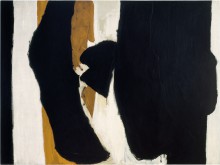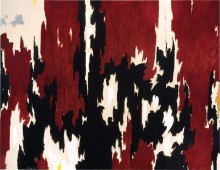Adolph Gottlieb
Transfiguration III 1958

Art © Adolph and Esther Gottlieb Foundation/Licensed by VAGA, New York, NY. Reproduction of this image, including downloading, is prohibited.
Gottlieb’s Transfiguration III expresses a different kind of energy. It is a “burst” painting, a typology Gottlieb conceived in 1957 that juxtaposes two shapes on a vertical axis. Set against a stark background, a haloed red oval hovers above a nest of black brushstrokes. The title alludes to the biblical account of Jesus Christ’s metamorphosis on a mountain, during which his body became radiant with divine light as his disciples looked on from below. Gottlieb conveys the essence of this event through the composition’s contrasting abstract forms.
Prior to the Andersons acquiring Transfiguration III, the work was in the personal collection of William Rubin, who was then Chief Curator of Painting and Sculpture at the Museum of Modern Art in New York.
-Sidney Simon, PhD ‘18
Spirituality and the Ethics of Inspiration
Transfiguration III is one of a series of Adolph Gottlieb’s paintings that critics call his “Burst Paintings”—upright, rectangular canvases on which two different-colored shapes hover one above the other, as though simultaneously attracting and repelling each other. The word “transfiguration” means a change of form. The title connotes Christian biblical tradition and recalls The Transfiguration by Italian Renaissance painter Raphael, which depicts Jesus revealing his divine form and floating above his disciples.
Gottlieb saw the significance of abstract painting as stemming from its content, rather than the technique displayed in the arrangement of lines and shapes. To reach this kind of content, he argued for using what he called “primitive” symbols, which he felt held the origins of human feeling. By “primitive,” Gottlieb meant a return to the ancient Greeks, biblical scripture, and Indigenous art. How does his idea of “primitivism” sit with you? Is it an example of artistic inspiration, appropriation, or maybe even both? Does it gloss over cultural differences or show thought-provoking commonalities?
—Callum Tresnan ‘23







